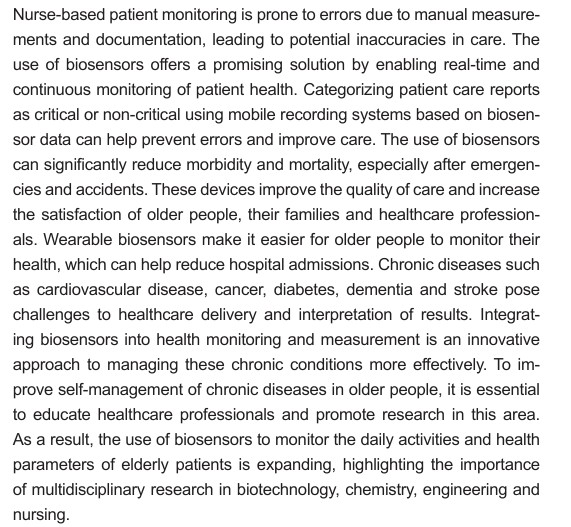Biosensor applications in the monitoring of elderly patients
DOI:
https://doi.org/10.62063/rev-12Keywords:
biosensor, geriatrics, wearable biosensor, innovative approaches, nursingAbstract
Nurse-based patient monitoring is prone to errors due to manual measurements and documentation, leading to potential inaccuracies in care. The use of biosensors offers a promising solution by enabling real-time and continuous monitoring of patient health. Categorizing patient care reports as critical or non-critical using mobile recording systems based on biosensor data can help prevent errors and improve care. The use of biosensors can significantly reduce morbidity and mortality, especially after emergencies and accidents. These devices improve the quality of care and increase the satisfaction of older people, their families and healthcare professionals. Wearable biosensors make it easier for older people to monitor their health, which can help reduce hospital admissions. Chronic diseases such as cardiovascular disease, cancer, diabetes, dementia and stroke pose challenges to healthcare delivery and interpretation of results. Integrating biosensors into health monitoring and measurement is an innovative approach to managing these chronic conditions more effectively. To improve self-management of chronic diseases in older people, it is essential to educate healthcare professionals and promote research in this area. As a result, the use of biosensors to monitor the daily activities and health parameters of elderly patients is expanding, highlighting the importance of multidisciplinary research in biotechnology, chemistry, engineering and nursing.
References
Arakawa, T., Dao, D. V., & Mitsubayashi, K. (2022). Biosensors and chemical sensors for healthcare monitoring: a review. IEEJ Transactions on Electrical and Electronic Engineering, 17(5), 626-636. https://doi.org/10.1002/tee.23580
Aziz, O., Park, E. J., Mori, G., & Robinovitch, S. N. (2014). Distinguishing the causes of falls in humans using an array of wearable tri-axial accelerometers. Gait & posture, 39(1), 506-512. https://doi.org/10.1016/j.gaitpost.2013.08.034
Bui, N., Pham, N., Barnitz, J. J., Zou, Z., Nguyen, P., Truong, H., Kim, T., Farrow, N., Nguyen, A., & Xiao, J. (2019). ebp: A wearable system for frequent and comfortable blood pressure monitoring from user’s ear. The 25th annual international conference on mobile computing and networking. https://doi.org/10.1145/3300061.3345454
Carek, A. M., Conant, J., Joshi, A., Kang, H., & Inan, O. T. (2017). SeismoWatch: wearable cuffless blood pressure monitoring using pulse transit time. Proceedings of the ACM on interactive, mobile, wearable and ubiquitous technologies, 1(3), 1-16. https://doi.org/10.1145/3130905
Chatterjee, N., Manna, K., Mukherjee, N., & Saha, K. D. (2022). Challenges and future prospects and commercial viability of biosensor-based devices for disease diagnosis. Biosensor Based Advanced Cancer Diagnostics, 333-352. https://doi.org/10.1016/B978-0-12-823424-2.00013-2
Chen, Y., Lu, S., Zhang, S., Li, Y., Qu, Z., Chen, Y., Lu, B., Wang, X., & Feng, X. (2017). Skin-like biosensor system via electrochemical channels for noninvasive blood glucose monitoring. Science advances, 3(12), e1701629. https://doi.org/10.1126/sciadv.1701629
Elsherif, M., Hassan, M. U., Yetisen, A. K., & Butt, H. (2018). Wearable contact lens biosensors for continuous glucose monitoring using smartphones. ACS nano, 12(6), 5452-5462. https://doi.org/10.1021/acsnano.8b00829
Garbern, S. C., Mbanjumucyo, G., Umuhoza, C., Sharma, V. K., Mackey, J., Tang, O., Martin, K. D., Twagirumukiza, F. R., Rosman, S. L., & McCall, N. (2019). Validation of a wearable biosensor device for vital sign monitoring in septic emergency department patients in Rwanda. Digital health, 5, 2055207619879349. https://doi.org/10.1177/2055207619879349
Hacker, K. (2024). The burden of chronic disease. Mayo Clinic Proceedings: Innovations, Quality & Outcomes, 8(1), 112-119. https://doi.org/10.1016/j.mayocpiqo.2023.08.005
Hanna, J., Bteich, M., Tawk, Y., Ramadan, A. H., Dia, B., Asadallah, F. A., Eid, A., Kanj, R., Costantine, J., & Eid, A. A. (2020). Noninvasive, wearable, and tunable electromagnetic multisensing system for continuous glucose monitoring, mimicking vasculature anatomy. Science advances, 6(24), eaba5320. https://doi.org/10.1126/sciadv.aba5320
Howcroft, J., Lemaire, E. D., & Kofman, J. (2016). Wearable-sensor-based classification models of faller status in older adults. PLoS one, 11(4), e0153240. https://doi.org/10.1371/journal.pone.0153240
Hussein, A. F., Hashim, S. J., Aziz, A. F. A., Rokhani, F. Z., & Adnan, W. A. W. (2017). A real time ECG data compression scheme for enhanced bluetooth low energy ECG system power consumption. Journal of Ambient Intelligence and Humanized Computing, 1-14. https://doi.org/10.1007/s12652-017-0560-y
Kalid, N., Zaidan, A., Zaidan, B., Salman, O. H., Hashim, M., & Muzammil, H. (2018). Based real time remote health monitoring systems: A review on patients prioritization and related” big data” using body sensors information and communication technology. Journal of medical systems, 42, 1-30. https://doi.org/10.1007/s10916-017-0883-4
Keating, N. (2022). A research framework for the United Nations Decade of Healthy Ageing (20212030). European Journal of Ageing, 19(3), 775-787. https://doi.org/10.1007/s10433-021-00679-7
Lázaro, J., Bailón, R., Gil, E., Noh, Y., Laguna, P., & Chon, K. H. (2018). Pilot study on electrocardiogram derived respiratory rate using a wearable armband. Computing in Cardiology Conference (CinC). https://doi.org/10.22489/CinC.2018.054
Ledikwe, J. H., Grignon, J., Lebelonyane, R., Ludick, S., Matshediso, E., Sento, B. W., Sharma, A., & Semo, B.-w. (2014). Improving the quality of health information: a qualitative assessment of data management and reporting systems in Botswana. Health research policy and systems, 12, 1-10. https://doi.org/10.1186/1478-4505-12-7
Lee, H., Song, C., Hong, Y. S., Kim, M., Cho, H. R., Kang, T., Shin, K., Choi, S. H., Hyeon, T., & Kim, D.-H. (2017). Wearable/disposable sweat-based glucose monitoring device with multistage transdermal drug delivery module. Science advances, 3(3), e1601314. https://doi.org/10.1126/sciadv.1601314
Leirós-Rodríguez, R., García-Soidán, J. L., & Romo-Pérez, V. (2019). Analyzing the use of accelerometers as a method of early diagnosis of alterations in balance in elderly people: A systematic review. Sensors, 19(18), 3883. https://doi.org/10.3390/s19183883
Li, T., Divatia, S., McKittrick, J., Moss, J., Hijnen, N. M., & Becker, L. B. (2019). A pilot study of respiratory rate derived from a wearable biosensor compared with capnography in emergency department patients. Open Access Emergency Medicine, 103-108. https://doi.org/0.2147/OAEM.S198842
Lin, Y.-J., Su, M.-J., Chen, S.-J., Wang, S.-C., Lin, C.-I., & Chen, H.-S. (2007). A study of ubiquitous monitor with RFID in an elderly nursing home. International Conference on Multimedia and Ubiquitous Engineering (MUE’07). https://doi.org/10.1109/MUE.2007.55
Miller, K., Baugh, C. W., Chai, P. R., Hasdianda, M. A., Divatia, S., Jambaulikar, G. D., & Boyer, E. W. (2021). Deployment of a wearable biosensor system in the emergency department: a technical feasibility study. Proceedings of the... Annual Hawaii International Conference on System Sciences. Annual Hawaii International Conference on System Sciences. https://doi.org/10.24251/HICSS.2021.433
Olmedo-Aguirre, J. O., Reyes-Campos, J., Alor-Hernandez, G., Machorro-Cano, I., Rodriguez Mazahua, L., & Sanchez-Cervantes, J. L. (2022). Remote healthcare for elderly people using wearables: A review. Biosensors, 12(2), 73. https://doi.org/10.3390/bios12020073
Pateraki, M., Fysarakis, K., Sakkalis, V., Spanoudakis, G., Varlamis, I., Maniadakis, M., Lourakis, M., Ioannidis, S., Cummins, N., & Schuller, B. (2020). Biosensors and Internet of Things in smart healthcare applications: Challenges and opportunities. Wearable and Implantable Medical Devices, 25-53. https://doi.org/10.1016/B978-0-12-815369-7.00002-1
Salek-Maghsoudi, A., Vakhshiteh, F., Torabi, R., Hassani, S., Ganjali, M. R., Norouzi, P., Hosseini, M., & Abdollahi, M. (2018). Recent advances in biosensor technology in assessment of early diabetes biomarkers. Biosensors and Bioelectronics, 99, 122-135. https://doi.org/10.1016/j.bios.2017.07.047
Saner, H. (2018). Wearable sensors for assisted living in elderly people. Frontiers in ICT, 5, 1. https://doi.org/10.3389/fict.2018.00001
Sani, M. I., Mutiara, G. A., & Putra, R. S. D. W. (2019). Fit-NES: Wearable bracelet for heart rate monitoring. TELKOMNIKA (Telecommunication Computing Electronics and Control), 17(1), 392-399. https://doi.org/10.12928/telkomnika.v17i1.11611
Smith, A. A., Li, R., & Tse, Z. T. H. (2023). Reshaping healthcare with wearable biosensors. Scientific Reports, 13(1), 4998. https://doi.org/10.1038/s41598-022-26951-z
Su, H., Sun, F., Lu, Z., Zhang, J., Zhang, W., & Liu, J. (2022). A wearable sensing system based on smartphone and diaper to detect urine in-situ for patients with urinary incontinence. Sensors and Actuators B: Chemical, 357, 131459. https://doi.org/10.1016/j.snb.2022.131459
Sun, X., Sun, X., Wang, Q., Wang, X., Feng, L., Yang, Y., Jing, Y., Yang, C., & Zhang, S. (2022). Biosensors toward behavior detection in diagnosis of alzheimer’s disease. Frontiers in Bioengineering and Biotechnology, 10, 1031833. https://doi.org/10.3389/fbioe.2022.1031833
TÜİK. Türkiye Yaşlı Profili Araştırması, 2023. Retrieved June, 27 from https://data.tuik.gov.tr/Bulten/Index?p=Turkiye-Yasli-Profili-Arastirmasi-2023-53809.
Tur García, E. (2014). Development of a flexible biosensor for the monitoring of lactate in human sweat for its medical use in pressure ischemia. Cranfield University, UK.
Vithya, G., & Vinayaga Sundaram, B. (2017). Inpatient critical stage monitoring in smart hospitals by contextual Fuzzy based QoS routing for WBMS network nurse call system. Wireless Personal Communications, 94, 2065-2080. https://doi.org/10.1007/s11277-016-3361-2
Wang, Z., Yang, Z., & Dong, T. (2017). A review of wearable technologies for elderly care that can accurately track indoor position, recognize physical activities and monitor vital signs in real time. Sensors, 17(2), 341. https://doi.org/10.3390/s17020341
Weenk, M., Koeneman, M., van de Belt, T. H., Engelen, L. J., van Goor, H., & Bredie, S. J. (2019). Wireless and continuous monitoring of vital signs in patients at the general ward. Resuscitation, 136, 47-53. https://doi.org/10.1016/j.resuscitation.2019.01.017
Xiao, N., Yu, W., & Han, X. (2020). Wearable heart rate monitoring intelligent sports bracelet based on Internet of things. Measurement, 164, 108102. https://doi.org/10.1016/j.measurement.2020.108102

Downloads
Published
How to Cite
Issue
Section
License
Copyright (c) 2024 Busra Kul

This work is licensed under a Creative Commons Attribution-NonCommercial 4.0 International License.







